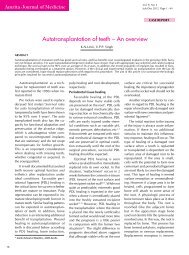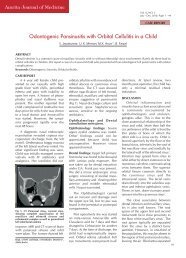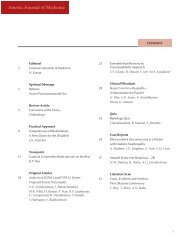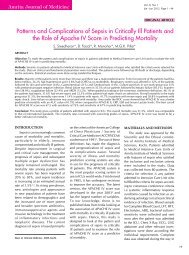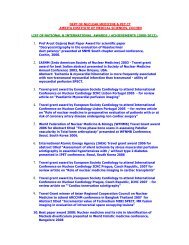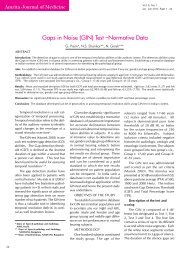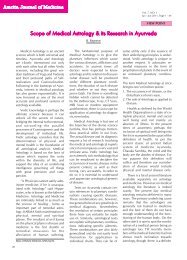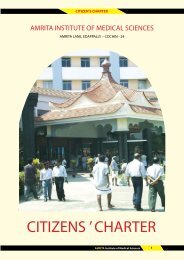Journal of Medicine Vol 2 - Amrita Institute of Medical Sciences and ...
Journal of Medicine Vol 2 - Amrita Institute of Medical Sciences and ...
Journal of Medicine Vol 2 - Amrita Institute of Medical Sciences and ...
Create successful ePaper yourself
Turn your PDF publications into a flip-book with our unique Google optimized e-Paper software.
<strong>Amrita</strong> <strong>Journal</strong> <strong>of</strong> <strong>Medicine</strong><br />
Obesity in Children <strong>and</strong> Adolescents<br />
obesity in adulthood, but if both parents are obese, the<br />
odds ratio increases to more than 10. Before 3 years <strong>of</strong><br />
age, parental obesity is a stronger predictor <strong>of</strong> obesity in<br />
adulthood than the child’s weight status 13 .<br />
NEUROENDOCRINOLOGY OF<br />
ENERGY METABOLISM<br />
Food intake <strong>and</strong> energy expenditure is controlled by<br />
complex neuroendocrine interactions. The hormone leptin<br />
is an important component <strong>of</strong> this complex system. Leptin<br />
is made almost exclusively in adipose tissue <strong>and</strong> acts<br />
centrally in the hypothalamus. Low plasma concentrations<br />
<strong>of</strong> leptin <strong>and</strong> insulin (e.g., during fasting <strong>and</strong> weight<br />
loss) increase food intake <strong>and</strong> decrease energy expenditure<br />
by stimulating neuropeptide Y (NPY) synthesis, <strong>and</strong><br />
perhaps by inhibiting sympathetic activity <strong>and</strong> other catabolic<br />
pathways 3 . High leptin <strong>and</strong> insulin concentrations<br />
(e.g., during feeding <strong>and</strong> weight gain) decrease food intake<br />
<strong>and</strong> increase energy expenditure through release <strong>of</strong><br />
melanocortin <strong>and</strong> corticotropin-releasing hormone (CRH),<br />
among others. The major peptides that stimulate feeding<br />
are orexins A <strong>and</strong> B, which are secreted by the hypothalamus,<br />
<strong>and</strong> ghrelin, which is secreted by the stomach 3 .<br />
VITAL PERIODS IN<br />
DEVELOPMENT OF OBESITY<br />
There are vital periods <strong>of</strong> development for excessive<br />
weight gain. Intrauterine influences play a major role in<br />
the genesis <strong>of</strong> obesity by influencing proportions <strong>of</strong> fat<br />
<strong>and</strong> lean body mass, central nervous system appetite control,<br />
<strong>and</strong> pancreatic structure <strong>and</strong> function.<br />
Epidemiological studies have demonstrated a direct affirmative<br />
relationship between birth weight <strong>and</strong> BMI<br />
attained in later life 14 . In addition, lower birth weight for<br />
gestational age has been associated with later risk for<br />
more central deposition <strong>of</strong> fat, which also confers increased<br />
cardiovascular risk. Rapid weight gain during<br />
infancy is also associated with obesity later in childhood 15 .<br />
The combination <strong>of</strong> lower birth weight <strong>and</strong> higher attained<br />
BMI is most robustly associated with later CVD<br />
risk 16 .<br />
Extent <strong>and</strong> period <strong>of</strong> breastfeeding have been found to<br />
be inversely associated with risk <strong>of</strong> obesity in later childhood<br />
17-20 . The normal tendency during early puberty for<br />
insulin resistance may be a natural c<strong>of</strong>actor for unwarranted<br />
weight gain as well as various comorbidities <strong>of</strong><br />
obesity 21 . Early menarche is clearly associated with extent<br />
<strong>of</strong> obesity, with a tw<strong>of</strong>old increase in rate <strong>of</strong> early<br />
menarche associated with BMI greater than the 85 th percentile<br />
22 . The risk <strong>of</strong> obesity persisting into adulthood is<br />
higher among obese adolescents than among younger children<br />
13 . Observations suggest that up to 80% <strong>of</strong> overweight<br />
adolescents will become obese adults 23 .<br />
ENVIRONMENTAL RISK<br />
FACTORS FOR OBESITY<br />
Environmental risk factors for overweight <strong>and</strong> obesity,<br />
including family <strong>and</strong> parental issues, are numerous <strong>and</strong><br />
complicated. Poor cognitive stimulation in the home <strong>and</strong><br />
low socioeconomic status predicts development <strong>of</strong> obesity<br />
24 . Parental food choices influence child food<br />
preferences 25 , <strong>and</strong> degree <strong>of</strong> parental adiposity is a marker<br />
for children’s fat preferences 26 . Children <strong>and</strong> adolescents<br />
<strong>of</strong> lower socioeconomic status have been reported to be<br />
less likely to eat fruits <strong>and</strong> vegetables <strong>and</strong> to have a higher<br />
intake <strong>of</strong> total <strong>and</strong> saturated fat 27-29 . Early rebound <strong>of</strong> the<br />
BMI is associated with an augmented risk <strong>of</strong> higher BMI<br />
in adulthood. A recent study links early rebound <strong>of</strong> BMI<br />
to glucose intolerance <strong>and</strong> diabetes in adults 30 .<br />
SOCIETAL CHANGES AND OBESITY<br />
Widespread <strong>and</strong> intense societal changes during the<br />
last several decades have contributed to childhood obesity.<br />
Leisure activity is ever more sedentary <strong>and</strong> there has<br />
Table 1: Adverse Outcomes in Childhood Obesity<br />
Metabolic<br />
Cardiovascular<br />
Psychological<br />
Orthopedic<br />
Neurological<br />
Hepatic<br />
Pulmonary<br />
Renal<br />
Malignancy<br />
Type 2 diabetes mellitus, impaired glucose tolerance<br />
Metabolic syndrome, hyper insulinism<br />
Dyslipidemia, atherosclerosis<br />
Hypertension, left ventricular hypertrophy<br />
Depression, poor quality <strong>of</strong> life<br />
Slipped capital femoral epiphysis<br />
Blount’s disease, osteoarthritis<br />
Pseudotumor cerebri<br />
Nonalcoholic steatohepatitis, gall bladder disease<br />
Obstructive sleep apnea, asthma (exacerbation)<br />
Proteinuria, FSGS<br />
Of ovary, breast, colon<br />
6



